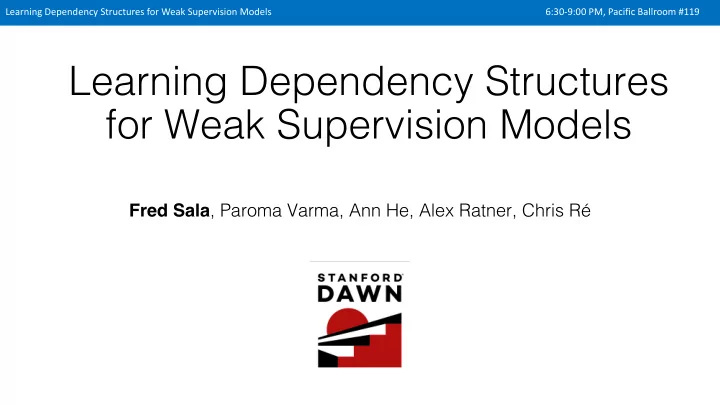

Learning Dependency Structures for Weak Supervision Models 6:30-9:00 PM, Pacific Ballroom #119 Learning Dependency Structures for Weak Supervision Models Fred Sala , Paroma Varma, Ann He, Alex Ratner, Chris Ré
Learning Dependency Structures for Weak Supervision Models 6:30-9:00 PM, Pacific Ballroom #119 Snorkel and Weak Supervision Ratner et al., Snorkel: “Rapid Training Data Creation with Weak Supervision”, VLDB 2017. Bach et al., “Snorkel DryBell: A Case Study in Deploying Weak Supervision at Frequent use in industry! Industrial Scale”, SIGMOD (Industrial) 2019.
Learning Dependency Structures for Weak Supervision Models 6:30-9:00 PM, Pacific Ballroom #119 The Snorkel/Weak Supervision Pipeline def def lf_1(x): 𝜇 " return return per_ heuristic(x) per_ def def lf_2(x): return return 𝜇 # 𝑍 doctor_ doctor_ pattern(x) def def lf_3(x): return return PROBABILISTIC 𝜇 $ hosp_ classifier(x) hosp_ TRAINING DATA LABELING FUNCTIONS LABEL MODEL END MODEL 1 2 3 Users write labeling We model the labeling We use the probabilistic functions to functions’ behavior to labels to train an noisily label data de-noise them arbitrary end model Requires Dependency Structure! Takeaway : No hand-labeled training data needed!
Learning Dependency Structures for Weak Supervision Models 6:30-9:00 PM, Pacific Ballroom #119 Model as Generative Process 𝜇 " def existing_classifier(x): “PERSON” return off_shelf_classifier(x) def upper_case_existing_classifier(x): 𝜇 # 𝑍 if all(map(is_upper, x.split())) and \ “PERSON” off_shelf_classifier(x) == ‘PERSON’: return PERSON def is_in_hospital_name_DB(x): “HOSPITAL” if x in HOSPITAL_NAMES_DB: return HOSPITAL 𝜇 $ Problem : learn the parameters of this model (accuracies & correlations) without 𝑍 ?
Learning Dependency Structures for Weak Supervision Models 6:30-9:00 PM, Pacific Ballroom #119 Solution Sketch: Using the covariance 𝜇 " 𝜇 # 𝜇 $ 𝑍 𝜇 " 𝜇 " Σ ( Σ = 𝜇 # 𝜇 # 𝑍 𝜇 $ 𝜇 $ 𝑍 Can only observe part of the covariance…
Learning Dependency Structures for Weak Supervision Models 6:30-9:00 PM, Pacific Ballroom #119 Idea: Use graph-sparsity of the inverse )" + 𝑨𝑨 , Σ )" ( = Σ ( 𝜇 " Observed Low-rank parameters overlaps to solve for 𝜇 # 𝑍 𝜇 $ Is zero where corresponding pair of variables has no edge [Loh & Wainwright 2013] Key : we must know the dependency structure
Learning Dependency Structures for Weak Supervision Models 6:30-9:00 PM, Pacific Ballroom #119 Idea: Use graph-sparsity of the inverse )" + 𝑨𝑨 , Σ )" ( = Σ ( Example: 8 LFs 1 triangle, 2 pairs, 1 singleton
Learning Dependency Structures for Weak Supervision Models 6:30-9:00 PM, Pacific Ballroom #119 Inverse Encodes The Structure… )" + 𝑨𝑨 , Σ )" ( = Σ (
Learning Dependency Structures for Weak Supervision Models 6:30-9:00 PM, Pacific Ballroom #119 But Observed Matrix Doesn’t )" + 𝑨𝑨 , Σ )" ( = Σ (
Learning Dependency Structures for Weak Supervision Models 6:30-9:00 PM, Pacific Ballroom #119 Need the Sparse Component… Can we extract the sparse part? )" = Σ )" ( − 𝑨𝑨 , Σ ( Sparse Low-Rank Observed = −
Learning Dependency Structures for Weak Supervision Models 6:30-9:00 PM, Pacific Ballroom #119 … & Robust PCA Recovers It! Need to decompose: )" = Σ )" ( − 𝑨𝑨 , Σ ( Sparse Low-Rank Observed Robust PCA : Decompose a matrix into sparse and low-rank components; sparse part contains graph structure Convex optimization: Candes et al., “Robust Principal Components Analysis?”, Chandrasekaran et al., “Rank-Sparsity Incoherence for Matrix Decomposition”
Learning Dependency Structures for Weak Supervision Models 6:30-9:00 PM, Pacific Ballroom #119 Theory Results: Sample Complexity m is # of LFs, d is largest degree for a dependency • Prior work : samples to recover WS dependency structure w. h. p. S. Bach, B. He, A. Ratner, C. Ré, “Learning the structure of generative models without labeled data”, ICML 2017. Ω(𝑛 log 𝑛) Doesn’t exploit d: sparsity of the graph structure • Recent application of RPCA for general latent-variable structure learning C. Wu, H. Zhao, H. Fang, M. Deng, “Graphical model selection with latent variables”, EJS 2017. Ω(𝑒 2 𝑛) Linear in m .
Learning Dependency Structures for Weak Supervision Models 6:30-9:00 PM, Pacific Ballroom #119 Theory Results: Sample Complexity m is # of LFs, d is largest degree for a dependency Ours : for τ < 1, an eigenvalue decay factor in blocks of LFs Ω(𝑒 2 𝑛 τ ) Ours : When there is a dominant block of correlated LFs Ω(𝑒 2 log 𝑛) Idea: exploit sharp concentration inequalities on sample covariance matrix Σ ( via the effective rank [Vershynin ’12]
Learning Dependency Structures for Weak Supervision Models 6:30-9:00 PM, Pacific Ballroom #119 Application: Bone Tumor Task Morpholo LF 3 LF 3 LF 3 LF 1 LF 2 LF 1 LF 2 LF 1 LF 2 gy-based features LF 4 LF 5 LF 6 LF 4 LF 5 LF 6 LF 4 LF 5 LF 6 Edge- based features LF 7 LF 8 LF 9 LF 7 LF 8 LF 9 LF 7 LF 8 LF 9 Bach et al. (2017) Ours/True Correlations Independent We pick up all the edges--- +4.64 F1 points, over indep., + 4.13 over Bach et al.
Learning Dependency Structures for Weak Supervision Models 6:30-9:00 PM, Pacific Ballroom #119 More Resources • Blog Post st: Intro to weak supervision https://dawn.cs.stanford.edu/2017/12/01/snorkel- programming/ • Blog Post st: Gentle Introduction to Structure Learning https://dawn.cs.stanford.edu/2018/06/13/structure • So Softwa ware : https://github.com/HazyResearch/metal Fred Sala : https://stanford.edu/~fredsala
Recommend
More recommend